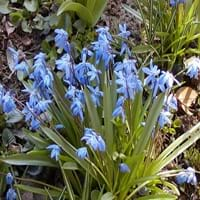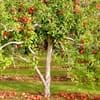Life Span
Perennial
Perennial
Type
Flowering Plants, Fruits, Trees
Bulb or Corm or Tuber
Origin
Central Asia
Europe, South Africa, Asia
Types
Aceymac apple, Bailey Sweet apple, Dabinett apple, Nehou apple
Scilla Siberica, Scilla Bifolia, Scilla Peruviana
Habitat
Hillside
Cultivated Beds, Woodland Garden
USDA Hardiness Zone
5-8
2-8
AHS Heat Zone
9-1
Not Available
Sunset Zone
A1, A2, A3, 8, 9, 10, 11, 12, 13, 14, 15, 16, 17, 18, 19, 20, 21, 22, 23, 24
21,22
Habit
Oval or Rounded
Clump-Forming
Minimum Height
Not Available
Minimum Width
Not Available
Flower Color
White
White, Blue, Purple, Pink, Violet
Flower Color Modifier
Not Available
Bicolor
Fruit Color
Green, Red
Not Available
Leaf Color in Spring
Dark Green
Not Available
Leaf Color in Summer
Green
Light Green
Leaf Color in Fall
Brown, Green, Light Yellow
Several shades of Green
Leaf Color in Winter
Not Available
Light Green
Leaf Shape
Oblong
Lance shaped
Plant Season
Spring
Not Available
Sunlight
Full Sun, Partial shade
Full Sun, Partial Sun, Partial shade
Growth Rate
Medium
Not Available
Type of Soil
Loamy
Not Available
The pH of Soil
Neutral
Not Available
Soil Drainage
Well drained
Not Available
Bloom Time
Fall, Summer
Not Available
Tolerances
Drought
Drought
Where to Plant?
Ground
Container, Ground, Pot
How to Plant?
Grafting, Seedlings, Transplanting
From bulbs
Plant Maintenance
Medium
Medium
Watering Requirements
Medium
Requires regular watering
In Summer
Lots of watering
Lots of watering
In Spring
Moderate
Moderate
In Winter
Average Water
Average Water
Soil pH
Neutral
Not Available
Soil Type
Loamy
Not Available
Soil Drainage Capacity
Well drained
Not Available
Sun Exposure
Full Sun, Partial shade
Full Sun, Partial Sun, Partial shade
Pruning
Prune when plant is dormant, Remove dead or diseased plant parts
No pruning needed
Fertilizers
All-Purpose Liquid Fertilizer
5-10-10 fertilizer
Pests and Diseases
Aphids, Canker, Caterpillars, Powdery mildew, Root rot
Crown rot
Plant Tolerance
Drought
Drought
Flower Petal Number
Single
Single
Foliage Texture
Medium
Medium
Foliage Sheen
Matte
Matte
Invasive
No
Not Available
Self-Sowing
Yes
Not Available
Allergy
Mouth itching, Throat itching
convulsions, Vomiting
Aesthetic Uses
Not Used For Aesthetic Purpose
Ground Cover
Beauty Benefits
Not Available
Removes dandruff
Environmental Uses
Air purification
Air purification
Medicinal Uses
Cancer, constipation, Diabetes, Diarrhea, Dysentry, Fever, Heart problems, Tooth ache
Antiasthamatic, Bronchitis, Lung Problems
Part of Plant Used
Fruits
Leaves, Root
Other Uses
Used As Food, Wood is used for making furniture
Used as a rodenticide, Used to make hair tonic
Used As Indoor Plant
No
Yes
Used As Outdoor Plant
Yes
Yes
Garden Design
Fruit / Fruit Tree, Shade Trees, Showy Tree
Container, Mixed Border, Rock Garden / Wall, Wildflower
Botanical Name
Malus domestica
SCILLA
Common Name
Apple Tree
Squill
In Hindi
सेब का वृक्ष
Squill
In German
Apfelbaum
Squill
In French
Pommier
Squille
In Spanish
Manzano
Escila
In Greek
μηλιά
σκιλοκρόμμυδο
In Portuguese
Macieira
Cila
In Polish
jabłoń
Cebulica
Phylum
Magnoliophyta
Magnoliophyta
Class
Magnoliopsida
Lilopsida
Family
Rosaceae
Liliaceae
Clade
Angiosperms, Eudicots, Rosids
Angiosperms, Monocots
Tribe
Not Available
Hyacintheae
Subfamily
Not Available
Scilloideae
Number of Species
Not Available
Importance of Apple Tree and Squill
Want to have the most appropriate plant for your garden? You might want to know the importance of Apple Tree and Squill. Basically, these two plants vary in many aspects. Compare Apple Tree and Squill as they differ in many characteristics such as their life, care, benefits, facts, etc. Every gardener must at least have the slightest clue about the plants he wants to plant in his garden. Compare their benefits, which differ in many ways like facts and uses. The medicinal use of Apple Tree is Cancer, constipation, Diabetes, Diarrhea, Dysentry, Fever, Heart problems and Tooth ache whereas of Squill is Antiasthamatic, Bronchitis and Lung Problems. Apple Tree has beauty benefits as follows: Not Available while Squill has beauty benefits as follows: Not Available.
Compare Facts of Apple Tree vs Squill
How to choose the best garden plant for your garden depending upon its facts? Here garden plant comparison will help you to solve this query. Compare the facts of Apple Tree vs Squill and know which one to choose. As garden plants have benefits and other uses, allergy is also a major drawback of plants for some people. Allergic reactions of Apple Tree are Mouth itching and Throat itching whereas of Squill have convulsions and Vomiting respectively. Having a fruit bearing plant in your garden can be a plus point of your garden. Apple Tree has showy fruits and Squill has no showy fruits. Also Apple Tree is flowering and Squill is not flowering . You can compare Apple Tree and Squill facts and facts of other plants too.





